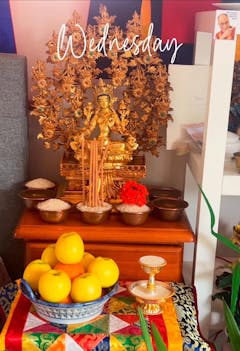Divine Chenrezig Sculpture | Embodying Compassion & Protection
Four-armed Avalokiteshvara Statue | Sacred Tibetan Bodhisattva Idol
24K Gold Gilded Chenrezig Statue from Nepal | Compassionate Deity
Sacred Bodhisattva Chenrezig Statue | Handcrafted Meditation Statue
Handcrafted Meditation Sculpture of Chenrezig | Handicrafted Statues
Avalokiteshvara Chenrezig Statue | Sacred Buddhist Sculpture from Nepal
Standing Chenrezig Statue | Gold Fire-Gilded Avalokiteshvara Sculpture
Standing Chenrezig Statue | Dark Oxidized Copper Buddhist Sculpture
Supreme Chenrezig Statue | Handicrafted Premium Nepalese Sculpture
Spiritual Chenrezig Statue | Handmade Statue for Inviting Compassion
Traditional Chenrezig Statue | Gold Fire-Gilded Tibetan Buddhist Art
White-Hued Four-armed Chenrezig Statue | Hand-Painted Meditation Decor
Who is Chenrezig?
Chenrezig, known as Avalokiteshvara in Sanskrit, is the revered Bodhisattva of Compassion in Mahayana and Tibetan Buddhism, symbolizing the infinite mercy and loving-kindness of all enlightened beings. Deeply venerated across the Himalayan region, Chenrezig is believed to hear the cries of suffering beings and respond with unconditional compassion. He is often depicted with four arms, holding a lotus flower, a wish-fulfilling jewel, and a rosary, each representing purity, boundless love, and continuous prayer. In Tibetan tradition, the Dalai Lama is considered an incarnation of Chenrezig, reinforcing his central role in spiritual guidance and protection.
Forms of Chenrezig
Chenrezig’s depiction is filled with rich symbolism, reflecting his immense compassion and wisdom. Various forms of Chenrezig are depicted across different traditions, but certain aspects remain constant:
-
Four-Armed Chenrezig: In this form, Chenrezig typically has four arms, with two hands in the prayer position (holding a lotus or performing a mudra of compassion) and the other two holding symbolic objects like a mala (rosary) and a jewel or lotus. His peaceful face exudes love, serenity, and compassion.
- Two-Armed Chenrezig: Two-Armed Chenrezig, also known as Avalokiteshvara in Sanskrit, is a serene and deeply compassionate form of the Bodhisattva of Compassion, revered throughout Tibetan Buddhism. In this form, Chenrezig is depicted seated in peaceful meditation, holding a crystal rosary in his right hand and a lotus flower or a wish-fulfilling jewel in his left.
-
Thousand-Armed Chenrezig: In some depictions, particularly in Vajrayana Buddhism, Chenrezig is shown with one thousand arms, each holding a different instrument representing his capacity to assist in countless ways. Every hand bears an eye in its palm, symbolizing his vigilance and ability to observe the suffering of the world, never turning away from it.
Chenrezig Mantra
Om Mani Padme Hum is the sacred mantra of Chenrezig (Avalokiteshvara), the bodhisattva of compassion.
-
Om – Purifies pride/ego (Deva realm)
-
Ma – Purifies jealousy/lust for entertainment (Asura realm)
-
Ni – Purifies passion and desire (Human realm)
-
Pad – Purifies ignorance and prejudice (Animal realm)
-
Me – Purifies possessiveness and greed (Hungry ghost realm)
-
Hum – Purifies hatred and aggression (Hell realm)
Benefits of Having a Chenrezig Statue
-
Inspires Daily Practice: A Chenrezig statue serves as a sacred reminder to live with compassion and mindfulness.
-
Spiritual Protection: The presence of the statue is believed to ward off negative energies and attract harmony.
-
Enhances Meditation: Gazing at the statue during meditation strengthens focus and deepens your connection with Chenrezig.
-
Blesses the Environment: The compassionate vibrations of the statue bless the home or temple space with peace and positivity.
-
Symbol of Hope: Chenrezig’s serene expression brings emotional comfort, especially during difficult times.
-
Promotes Healing: Believers associate the statue with emotional and even physical healing through devotion.
-
Cultural and Artistic Beauty: Often hand-carved by skilled Himalayan artisans, Chenrezig statues reflect deep spiritual and artistic heritage.
Craftsmanship and Materials Used for Making Chenrezig Statue
Chenrezig Statue is a result of exceptional Himalayan craftsmanship, blending sacred tradition with masterful artistry. Handcrafted in Patan, Nepal, a city renowned for its centuries-old Buddhist sculpture heritage, this Chenrezig statue is meticulously created by master artisans who have inherited skills passed down through generations.
Our Chenrezig statue is made using the traditional Lost Wax Method, an ancient sculpting technique that allows for fine, intricate detailing.
Premium Copper or Oxidized Copper is used as the base material, offering durability and a timeless aesthetic. In some statues, the surface is adorned with 24k fire-gilded gold, a sacred process where pure gold is applied using heat to bond it to the copper surface, giving the statue a radiant and divine glow. Additionally, many Chenrezig statues are decorated with semi-precious stones, carefully inlaid by hand to enhance their beauty and spiritual richness.
This exceptional combination of materials and traditional techniques ensures that each Chenrezig statue is not only a profound spiritual icon but also a collector’s piece of authentic Himalayan Buddhist art.
Shop Our Beautifully Hand-carved Chenrezig Statues
Discover the serene presence of Chenrezig, the embodiment of compassion, and invite his peaceful energy into your life. Whether you seek emotional healing, spiritual support, or a deeper connection to your practice, a Chenrezig statue serves as a powerful reminder of love and kindness. Let this divine figure inspire your heart and home with harmony and inner calm. Begin your journey toward peace and spiritual awakening—Shop the Chenrezig collection now and feel the transformative power of compassion.






































































